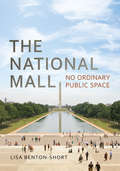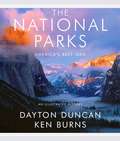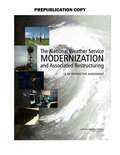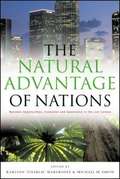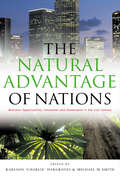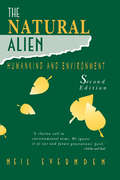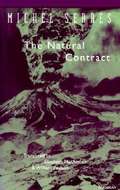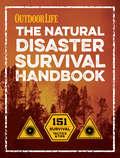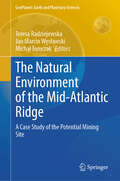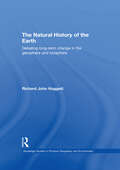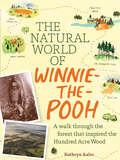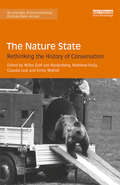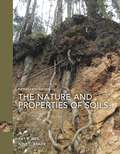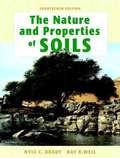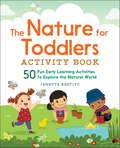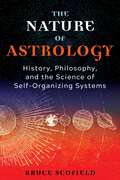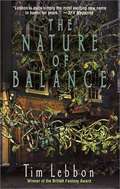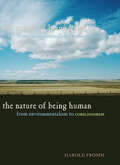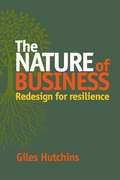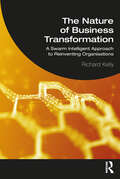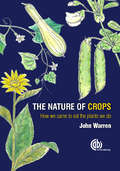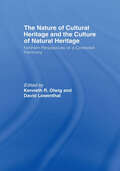- Table View
- List View
The National Mall: No Ordinary Public Space
by Lisa Benton-ShortThe National Mall in Washington, D.C. is one of the most important and highly visible urban public spaces in the U.S. It is considered by many Americans to be "the nation's front yard." Yet few have written about the role of this public space in the twenty-first century. In The National Mall, Lisa Benton-Short explores the critical issues that are redefining and reshaping this extraordinary public space. Her work focuses on three contemporary and interrelated debates about public space: the management challenges faced by federal authorities, increased demands for access and security post 9/11, and the role of the public in the Mall's long-term planning and development plans. By taking a holistic view of the National Mall and analyzing the unique twenty-first century challenges it faces, Lisa Benton-Short provides a fluid, cohesive, and timely narrative that is as extraordinary as the Mall itself.
The National Parks: An Illustrated History
by Ken Burns Dayton DuncanThe companion volume to the new Ken Burns film: a magnificently illustrated history of the American National Park System. In a rich, deeply informative narrative, Dayton Duncan and Ken Burns examine how each new park was brought into the system.
The National Weather Service Modernization and Associated Restructuring
by Committee on the Assessment of the National Weather Service's Modernization ProgramThe Modernization and Associated Restructuring (MAR) of the National Weather Service (NWS) was a large and complex re-engineering of a federal agency. The process lasted a decade and cost an estimated $4.5 billion. The result was greater integration of science into weather service activities and improved outreach and coordination with users of weather information. The MAR created a new, modernized NWS, and, significantly, it created a framework that will allow the NWS to keep up with technological changes in a more evolutionary manner. The MAR was both necessary and generally well executed. However, it required revolutionary, often difficult, changes. The procurement of large, complex technical systems presented challenges in and of itself. The MAR also affected the career paths and personal lives of a large portion of the field office workforce. The MAR created a new, modernized NWS, and, significantly, it created a framework that will allow the NWS to keep up with technological changes in a more evolutionary manner. The National Weather Service Modernization and Associated Restructuring presents the first comprehensive assessment of the execution of the MAR and its impact on the provision of weather services in the United States. This report provides an assessment that addresses the past modernization as well as lessons learned to support future improvements to NWS capabilities.
The Natural Advantage of Nations: Business Opportunities, Innovation and Governance in the 21st Century
by Charlie Hargroves Michael H. SmithThe days of trade-offs between the environment, society, and business are over, proclaim professionals and researchers with The Natural Edge Project. They walk particularly business leaders but also other readers through the various dimensions of sustainability and the actors and forces at work in each. The themes are the need for a new paradigm, natural advantage as a business imperative, achieving a natural advantage of nations, sustainable cities, and a national collaborative approach.
The Natural Advantage of Nations: Business Opportunities, Innovations and Governance in the 21st Century
by Michael H. Smith KarlsonThis book is more than just a 'palliative care' guide for the planet - it is about innovation, solutions, competitiveness and profitability. At work, at home and as members of society, our generation has an opportunity - to be part of the obligation - and an exciting solution in restoring the balance. The authors present a bold vision for the future and demonstrate how we can get there, drawing on lessons of competitive advantage theory and the latest in sustainability, economics, innovation, business and governance theory and practice. The result is nothing less than the most authoritative and comprehensive guide to date, to building the new ecologically sustainable economy. For further information about The Natural Edge Project and to view the book's online companion, visit www.naturaledgeproject.net.
The Natural Alien
by Neil EverndenIn this eloquent and sympathetic book, Evernden evaluates the international environmental movement and the underlying assumptions that could doom it to failure. Beginning with a simple definition of environmentalists as "those who confess a concern for the non-human," he reviews what is inherent in industrial societies to make them so resistant to the concerns of environmentalists. His analysis draws on citing such diverse sources as Merleau-Ponty, Heidegger, and TIME, and examines how we tend to think about the world and how we might think about it.The book does not offer solutions to environmental questions, but it does offer the hope that there can be new ways of thinking and flexibility in human/environmental relations. Although humans seem alienated from our the natural world, we can develop a new understanding of `self in the world.'The second edition has a new preface and an epilogue in which Evernden analyses the latest environmental catch-phrase: sustainable development.
The Natural Alien: Humankind and Environment
by Neil EverndenAn aura of success seems to surround the environmental movement today. Its concerns are voiced by news media and heeded by governments around the world. But its real achievements have been few, and the publicity they have generated may disguise the movement's essential futility. In this thoughtful and sympathetic evaluation of the international environmental movement Evernden raises grave doubts about its ability even to express adequately its real message, let alone to establish societal acceptance and government support for it. He reviews the assumptions inherent in western industrial societies that make them so resistant to the basic motivating concerns of those active in the environmental cause. From that analysis Evernden considers an alternative view of human/ environmental relations as presented by such thinkers as Merleau-Ponty and Heidegger. Their evocation of self as 'being in the world' is quite different from the dominant 'Cartesian' view, and far more accommodating to the environmentalist's sensibility. Evernden argues that the existence of such differing approaches to human/environment relations is evidence of a flexibility that is a basic feature of humanity. In this flexibility lies the basis of hope. Our uncertainty, although predisposing us to confusion and alienation, also enables us to develop a new understanding of 'self in world.' Only through such understanding can the impulse to environmental advocacy be understood.
The Natural City
by Ingrid Leman Stefanovic Stephen Bede ScharperUrban and natural environments are often viewed as entirely separate entities - human settlements as the domain of architects and planners, and natural areas as untouched wilderness. This dichotomy continues to drive decision-making in subtle ways, but with the mounting pressures of global climate change and declining biodiversity, it is no longer viable. New technologies are promising to provide renewable energy sources and greener designs, but real change will require a deeper shift in values, attitudes, and perceptions. A timely and important collection, The Natural City explores how to integrate the natural environment into healthy urban centres from philosophical, religious, socio-political, and planning perspectives. Recognizing the need to better link the humanities with public policy, The Natural City offers unique insights for the development of an alternative vision of urban life.
The Natural Contract (Studies in Literature and Science)
by Michel Serres Elizabeth MacArthur William PaulsonGlobal environmental change, argues Michel Serres, has forced us to reconsider our relationship to nature. In this translation of his influential 1990 book Le Contrat Naturel, Serres calls for a natural contract to be negotiated between Earth and its inhabitants. World history is often referred to as the story of human conflict. Those struggles that are seen as our history must now include the uncontrolled violence that humanity perpetrates upon the earth, and the uncontrollable menace to human life posed by the earth in reaction to this violence. Just as a social contract once brought order to human relations, Serres believes that we must now sign a "natural contract" with the earth to bring balance and reciprocity to our relations with the planet that gives us life. Our survival depends on the extent to which humans join together and act globally, on an earth now conceived as an entity. Tracing the ancient beginnings of modernity, Serres examines the origins and possibilities of a natural contract through an extended meditation on the contractual foundations of law and science. By invoking a nonhuman, physical world, Serres asserts, science frees us from the oppressive confines of a purely social existence, but threatens to become a totalitarian order in its own right. The new legislator of the natural contract must bring science and law into balance. Serres ends his meditation by retelling the story of the natural contract as a series of parables. He sees humanity as a spacecraft that with the help of science and technology has cast off from familiar moorings. In place of the ties that modernity and analytic reason have severed, we find a network of relations both stranger and stronger than any we once knew, binding us to one another and to the world. The philosopher's harrowing and joyous task, Serres tells us, is that of comprehending and experiencing the bonds of violence and love that unite us in our spacewalk to the spaceship Mother Earth.
The Natural Disaster Survival Handbook: 151 Survival Tactics & Tips (Outdoor Life)
by The Editors of Outdoor LifeHow to survive everything from hurricanes and wildfires to earthquakes and tsunamis, from the editors of Outdoor Life. From basic precautions like knowing how to use a fire extinguisher to emergencies like riding out an avalanche, this comprehensive collection of practical advice prepares you to protect yourself, your home, and your family in a wide variety of situations. Included are sections on: The Essential: Get ready with the right emergency kit and first aid supplies. Be ready for earthquakes, floods, blizzards, and other natural disasters wherever you may be. Learn simple tips and techniques for treating common injuries, assessing danger, and getting to safety fast. The Extreme: When a tornado is bearing down on your car, the floodwaters have cut off your home, or you&’re camping and the lightning strikes seem to be getting closer—what do you do? This book tells you, in simple steps with handy illustrations. The Emergency: Mudslides, avalanche, falling boulders often start without warning, leaving little time to prepare—or even think. Be prepared for the worst so you can react quickly. From the premier publication that was founded nearly 125 years ago, this is a valuable resource for those who want to be ready for anything nature throws at them.
The Natural Environment of the Mid-Atlantic Ridge: A Case Study of the Potential Mining Site (GeoPlanet: Earth and Planetary Sciences)
by Teresa Radziejewska Jan Marcin Węsławski Michał TomczakThe book presents the first comprehensive description of parts of the Mid-Atlantic ridge subject to a contract for polymetallic sulphide exploration between the International Seabed Authority and the Ministry of Environment of the Republic of Poland. The state-of-the-art of the study area presented here takes into account a variety of aspects, including hydrological and meteorological conditions, hydrography, optical properties of water, seafloor morphology, geology, sediments and sedimentation processes, pelagic environment and its biocoenosis, benthic organisms, seabed communities, deep-sea environmental protection, as well as many other. Also, the research methods and tools are enumerated, and the studies advised for the future are outlined. The Atlantic seabed area described in this monograph is situated near the central part of the Mid-Atlantic Ridge (MAR), one of the major geological formations on Earth, featuring - like other mid-oceanic ridges - active and inactive hydrothermal vent fields with their unusual and unique ecosystems. The commercial interest in MAR exploration is due to the deposits of massive polymetallic sulphides, formed as a result of hydrothermal fluid precipitation.
The Natural History of Earth: Debating Long-Term Change in the Geosphere and Biosphere (Routledge Studies in Physical Geography and Environment)
by Richard John HuggettUsing a broad selection of classic and current sources, The Natural History of the Earth probes selected discussions within biology, climatology, geology, and geomorphology and explores a selection of debates about Earth and life history, considering their origins and their present state-of-play. After outlining the arguments, placing them in an historical context and indicating their significance, the book goes on to deal with specific debates. In the geosphere section, topics covered include geological processes, the bombardment hypothesis, frigid climates and cataclysmic floods, and in the section concerning the biosphere, the topics covered include evolutionary patterns, mass extinctions, patterns in life’s history and life–environment connections. Written in a clear and accessible style, this volume will interest Earth and life scientists, physical geographers and any informed person fascinated by long-term Earth history. This accessible volume is illustrated throughout with over fifty informative diagrams, photographs, tables and over 700 references.
The Natural World of Winnie-the-Pooh: A Walk Through the Forest that Inspired the Hundred Acre Wood
by Kathryn AaltoLoved “Goodbye Christopher Robin”? Learn more about the real place that inspired the beloved stories. Delve into the home of the world’s most beloved bear! The Natural World of Winnie-the-Pooh explores the magical landscapes where Pooh, Christopher Robin, and their friends live and play. The Hundred Acre Wood—the setting for Winnie-the-Pooh’s adventures—was inspired by Ashdown Forest, a wildlife haven that spans more than 6,000 acres in southeast England. In the pages of this enchanting book you can visit the ancient black walnut tree on the edge of the forest that became Pooh’s house, go deep into the pine trees to find Poohsticks Bridge, and climb up to the top of the enchanted Galleons Lap, where Pooh says goodbye to Christopher Robin. You will discover how Milne's childhood connection with nature and his role as a father influenced his famous stories, and how his close collaboration with illustrator E. H. Shepard brought those stories to life. This charming book also serves as a guide to the plants, animals, and places of the remarkable Ashdown Forest, whether you are visiting in person or from the comfort of your favorite armchair. In a delightful narrative, enriched with Shepard’s original illustrations, hundreds of color photographs, and Milne’s own words, you will rediscover your favorite characters and the magical place they called home.
The Nature State: Rethinking the History of Conservation (Routledge Environmental Humanities)
by Matthew Kelly Claudia Leal Emily Wakild Wilko Graf HardenbergThis volume brings together case studies from around the globe (including China, Latin America, the Philippines, Namibia, India and Europe) to explore the history of nature conservation in the twentieth century. It seeks to highlight the state, a central actor in these efforts, which is often taken for granted, and establishes a novel concept – the nature state – as a means for exploring the historical formation of that portion of the state dedicated to managing and protecting nature. Following the Industrial Revolution and post-war exponential increase in human population and consumption, conservation in myriad forms has been one particularly visible way in which the government and its agencies have tried to control, manage or produce nature for reasons other than raw exploitation. Using an interdisciplinary approach and including case studies from across the globe, this edited collection brings together geographers, sociologists, anthropologists and historians in order to examine the degree to which sociopolitical regimes facilitate and shape the emergence and development of nature states. This innovative work marks an early intervention in the tentative turn towards the state in environmental history and will be of great interest to students and practitioners of environmental history, social anthropology and conservation studies.
The Nature and Properties of Soils
by Nyle Brady Ray Weil<p>This hallmark text introduces the exciting world of soils through clear writing, strong pedagogy, and an ecological approach that effectively explains the fundamentals of soil science. Worked calculations, vignettes, and current real-world applications prepare readers to understand concepts, solve problems, and think critically. Written for both majors and non-majors, this text highlights the many interactions between the soil and other components of forest, range, agricultural, wetland and constructed ecosystems. <p>Now in full-color, the Fifteenth Edition includes hundreds of compelling photos, figures, and diagrams to bring the exciting world of soils to life. Extensively revised, new and updated content appears in every chapter. Examples include: coverage of the pedosphere concept; new insights into humus and soil carbon accumulation; subaqueous soils, soil effects on human health; principles and practice of organic farming; urban and human engineered soils; new understandings of the nitrogen cycle; water-saving irrigation techniques; hydraulic redistribution, soil food-web ecology; disease suppressive soils; soil microbial genomics; soil interactions with global climate change; digital soil maps; and many others.</p>
The Nature and Properties of Soils
by Nyle C. Brady Ray R. WeilThe Nature and Property of Soils is an engaging book for readers. It has an ecological approach that explains the fundamentals of soil science effectively. Chapter topics include Soil Erosion and Its Control, Soil Acidity, Soils and Chemical Pollution, and Organisms and the Ecology of the Soil. For individuals interested in soil and the environment.
The Nature for Toddlers Activity Book: 50 Fun Early Learning Activities to Explore the Natural World
by Jenette RestivoGo exploring with 50 outdoor activities for toddlers!Nature is full of sights, sounds, and textures to fascinate toddlers and engage their growing minds. Encourage them to discover the world around them with this book of hands-on nature activities. From Rainy Day Puddle Stomping to Rock Stacking and Creating a Bird Feeding Station, your little one will practice key skills as they build a love of the great outdoors. Learning in action—Watch as your toddler begins to ask questions, recognize cause and effect, sort objects, and develop their motor skills. Anytime and anywhere—Most of these activities only take about 20 minutes, use basic household items, and can be done in your backyard, your local park, or around the neighborhood. Every part of nature—Dig into activities that teach toddlers about weather and seasons, soil and rocks, creatures and critters, and green things that grow! Get little ones excited to get outside w ith The Nature for Toddlers Activity Book.
The Nature of Astrology: History, Philosophy, and the Science of Self-Organizing Systems
by Bruce Scofield• Shares modern biological studies offering evidence that our solar system neighbors profoundly affect and shape life on our planet • Explores the early practice of astrometeorology, revealing the links between the solar system, weather, and climate over large spans of time • Looks at the history, philosophy, and methodologies of astrology, as well as its potential future applications in medicine and the social sciences Our ancient ancestors recorded the rhythms of the Sun, Moon, planets, and stars, correlating these rhythms with weather, plant growth, and animal and human behaviors. From these early geocosmic recordings were born calendars, astronomy, and astrology. While astrology is now mostly viewed as subjective fortune-telling, Bruce Scofield argues that astrology is not only a practice but also a science, specifically a form of systems science--a set of techniques for mapping and analyzing self-organizing systems. Providing clear evidence that our solar system neighbors profoundly affect and shape life on our planet, Scofield shares modern biological and climatological studies on the effects of Earth&’s rotation, the Sun, the Moon, and the rhythms of light, gravity, magnetism, and solar radiation on terrestrial processes. He explores the early practice of astrometeorology, a method of weather forecasting used from ancient times into the Renaissance, revealing the links between the solar system, weather, and climate over large spans of time. He shares his own studies on the correlations between Saturn&’s position and terrestrial weather as well as presenting a wealth of evidence on astrological effects and the theories and mechanics behind them. Examining the history of astrology, he looks at its earliest foundations in Mesopotamia and its development by the classical Greeks into a mathematically informed body of knowledge. He explores the decline and marginalization of astrology during the Scientific Revolution of the Renaissance and the Enlightenment, when astrology was transformed from a credible science to a controversial practice after being attacked by the Church and then abandoned by experimental scientists. Presenting a broad look at how the cosmic environment shapes nature, the author shows how the practice and natural science of astrology can expand its applications in modern society in such varied fields as medicine, history, and sociology.
The Nature of Balance
by Tim LebbonOne morning, the world does not wake up. People lie dead in their beds, killed by their own nightmares. They're lucky. For the few remaining survivors, the new world is a confusing, terrifying place.
The Nature of Being Human: From Environmentalism to Consciousness
by Harold FrommEssays exploring humanity’s connection with the environment.Although the physical relationship between the natural world and individuals is quantifiable, the psychosocial effect of the former on the latter is often less tangible. What, for instance, is the connection between the environment in which we live and our creativity? How is our consciousness bounded and delimited by our materiality? And from whence does our idea of self and our belief in free will derive and when do our surroundings challenge these basic assumptions?Eco-critic Harold Fromm’s challenging exploration of these and related questions twines his own physical experiences and observations with insights gathered from both the humanities and the sciences. Writing broadly and personally, Fromm explores our views of nature and how we write about it. He ties together ecology, evolutionary psychology, and consciousness studies to show that our perceived separation from our surroundings is an illusory construct. He argues for a naturalistic vision of creativity, free will, and the literary arts unimpeded by common academic and professional restraints. At each point of this intellectual journey, Fromm is honest, engaging, and unsparing.Philosophical, critical, often personal, Fromm’s sweeping, interdisciplinary, and sometimes combative essays will change the way you think about your place in the environment.“How rare it is that a work of philosophical inquiry is written with the passion of a cri de coeur, but Harold Fromm’s brilliantly conceived The Nature of Being Human resonates with such uncanny depths. Here is an utterly engrossing first-person account of a harrowing pilgrimage into the 21st century and its disturbing revelations about humankind’s truest nature, in contrast to the comforting solicitudes of a “humanist” past. If the role of the philosopher is to force us to think, Harold Fromm is a born philosopher.” —Joyce Carol Oates“Fromm, an erudite, prolific author of numerous works ranging from ecocritical commentary to self-reflective discourses, presents a compilation of essays that illuminate his views regarding why most Americans seem oblivious to the destruction of their environment.” —Choice“Fromm’s journey from victim, to campaigner, to pioneer of eco-criticism (that is, the study of literature from an ecological viewpoint) is documented here, alongside challenging analyses of man’s place in nature, free will, our relationship with technology and more. Scholarly but engaging, Fromm is an environmentalist, but also a realist.” —Organic Gardener
The Nature of Business
by Giles HutchinsNature has already shown us the way to solve many human problems, from deciphering simple engineering puzzles to unlocking the mysteries of flight. In The Nature of Business, Giles Hutchins makes a compelling case for applying the same principles of biomimicry to the development of a new business paradigm. He demonstrates clearly how behaviors and organizations found in nature can be applied to help companies flourish in chaotic and uncertain times.Eclipsing current approaches to responsible and green business, Hutchins' focus is on the emergence of new ways of operating and creating value in an increasingly volatile and interconnected world. He presents the challenges to the prevailing "business as usual" model, explains the pressing need for transformational change, and reveals the concepts and mindsets necessary to inspire the businesses of tomorrow, including:* Resilience* Optimization and adaptation* Systems integration* Values-based navigation and life-building activitiesShowcasing the pioneers of the new paradigm through a multitude of examples and case studies, The Nature of Business presents the tools and techniques required to effect the transformation to an organization fit for purpose, fit for the future, and inspired by nature.Giles Hutchins is a management consultant who guides businesses and organizations through the process of redesigning for resilience in challenging times. He is the co-founder of BCI: Biomimicry for Creative Innovation.
The Nature of Business Transformation: A Swarm Intelligent Approach to Reinventing Organisations
by Richard KellyThis book is a practical guide for business professionals to develop and improve business intelligence and collective decision-making within their organisation. It proposes a progressive reconfiguration of the traditional business operating system using a nature-inspired framework called swarm facilitation that enables and facilitates collective decision-making. Organisations have followed the same rigid formula of problem-solving and decision-making for over 100 years. It is dominated by centralised governance and pyramid decision-making. Such an approach is no longer fit for purpose in an environment of employee disengagement, artificial intelligence (AI)/superintelligence, and Covid-19 fallout. By the end of this book, readers will be able to: • solve organisational problems and challenges collectively using swarm intelligence; • upgrade and future-proof business operating systems to reflect a more collective decision-making approach fit for the new connected economy and Industry 4.0; • embrace mindset quotients that support people working in a more networked, self-organising, and collective environment. The book is important reading for leaders and managers who are focused on building organisational capital and engagement and gaining value from the emerging technology by evolving their business operating system into a digital ecosystem as part of an ongoing digital transformation strategy. It will also appeal to experts working in the field of organisational change and development, both within the organisation and as consultants.
The Nature of Crops
by Professor John WarrenHave you ever wondered why we eat wheat, rice, potatoes and cassava? Why we routinely domesticate foodstuffs with the power to kill us, or why we chose almonds over acorns? Answering all these questions and more in a readable and friendly style, this book takes you on a journey through our history with crop plants. Arranged into recurrent themes in plant domestication, this book documents the history and biology of over 50 crops, including cereals, spices, legumes, fruits and cash crops such as chocolate, tobacco and rubber. In The Nature of Crops John Warren reveals: -Why the Egyptians worshipped onions; -Why red-flowering runner beans provide fewer beans than white-flowering; -The inherent dangers of being a pineapple worker; and -Why a bird will always beat you in a chilli pepper eating competition!
The Nature of Cultural Heritage, and the Culture of Natural Heritage
by Kenneth R. Olwig and David LowenthalThe idea that the heritage of nature is fundamentally cultural is provocative to many, but it is becoming increasingly accepted in the context of heritage preservation. It is argued here that a person’s perspective on natural vs. cultural heritage as a contested patrimony is, to some extent, governed by one’s intellectual and geographical position. In discourses influenced by the natural sciences culture is a heritage of nature, whereas in those deriving from the humanities and social sciences, nature is defined socio-culturally. There is also, however, a geographical dimension to how one looks at the nature culture relation. From at least the time of Aristotle, the North has been identified with a cultural heritage thought to derive from the northern natural environment. It was no longer culture, as represented by the architectural monuments of the South, but the natural landscape that provided the measure for both natural and cultural heritage, as the natural landscape and its ecosystems were put in focus. This essay provides a contemporary picture of the long-standing contestation between natural and cultural heritage that provided the basis for the northern perspective taken in these essays.This book was previously published as a special issue of The International Journal of Heritage Studies.
The Nature of Culture
by Miriam N. Haidle Nicholas J. Conard Michael BolusThis volume introduces a model of the expansion of cultural capacity as a systemic approach with biological, historical and individual dimensions. It is contrasted with existing approaches from primatology and behavioural ecology; influential factors like differences in life history and demography are discussed; and the different stages of the development of cultural capacity in human evolution are traced in the archaeological record. The volume provides a synthetic view on a) the different factors and mechanisms of cultural development, and b) expansions of cultural capacities in human evolution beyond the capacities observed in animal culture so far. It is an important topic because only a volume of contributions from different disciplines can yield the necessary breadth to discuss the complex subject. The model introduced and discussed originates in the naturalist context and tries to open the discussion to some culturalist aspects, thus the publication in a series with archaeological and biological emphasis is apt. As a new development the synthetic model of expansion of cultural capacity is introduced and discussed in a broad perspective.
